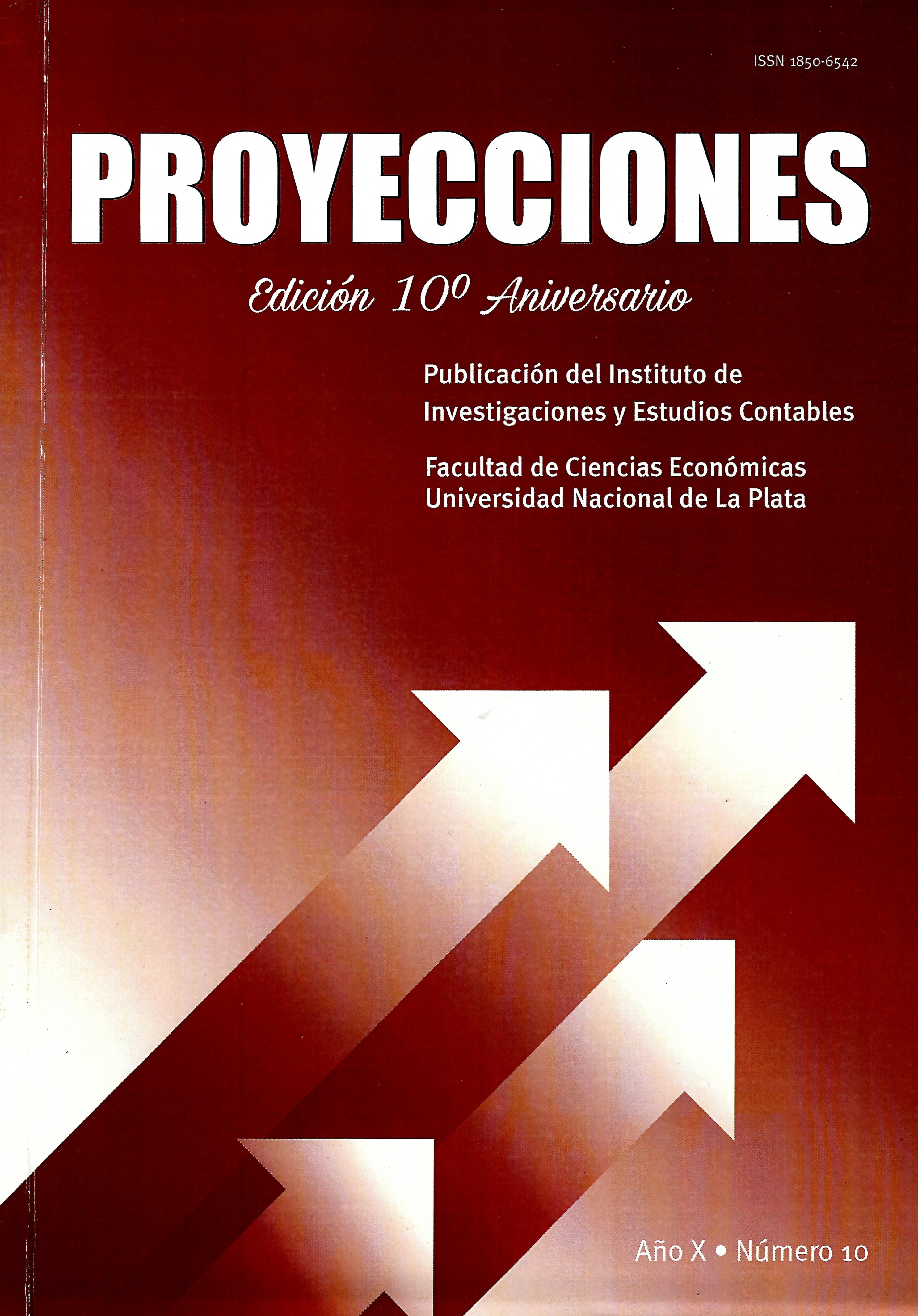Los Recursos Naturales, el Petróleo y las Normas Contables
Keywords:
Oil, Exploration costs, Financial Accounting, Supplementary informationAbstract
Oil and minerals are natural resources subject to international regulations regarding their exploitation, use and enjoyment. UN creation in 1945 established the self-determination of countries and their permanent sovereignty over their natural resources as a sine qua non.
Search for oil or gas is termed by Oil Industry “exploration” whose basic goal is the incorporation of new proven reserves, i.e. keeping an inventory of crude which can be processed in order to enable oil supply during a long period of time. Exploration’s main objective is to maximize long term Economic Value of both gaseous and non-gaseous hydrocarbon’s reserves. Sustainable exploration means developing the mentioned process showing respect for the staff of the company and the environment.
Originally, Oil Industry managed to find deposits with ease as they were either both superficial and already discovered ones or oilfields found by chance. Nevertheless, the increasingly relevance of this industry led to an intensive and rational search for new deposits which turned into a science with contributions from other disciplines like Geology, Physics and Chemistry. Nowadays, the discovery of oilfields is the result of an organized plan developed with scientific methodology which involves high-technology equipment as well as specialists which are transferred to often uninhabited regions like jungles or deserts. As a result of the foregoing, roads are built, communications are developed, helicopters are used and camps and laboratories are set up.
The Accounting discipline has to fulfill its function by enabling the development of reports which satisfy users’ multiple requirements as well as revealing financial, economical and social interrelationship among the different organizations. Moreover, information regarding both places with possible hydrocarbon accumulation and costs associated with their verification should be revealed, as well. Financial Statements should also reveal the activities undertaken by the organization in order to increase certainty and the amount of reserves.
The uniqueness of Oil Industry, the uncertainty about the success or failure of exploration activities, the long cycle of operations between the initial investment and the first hydrocarbon production, the efforts demanded for the evaluation whether to exploit or not a deposit and the estimation of discounted future cash flows associated with complex agreements among companies to share risks which usually also involve the countries were those resources are located present challenges to Financial Accounting.
IFRS 6 “Exploration for and Evaluation of Mineral Resources” published by IASB in 2004 was a step in the right direction. We agree with the criteria set by IASB regarding their non-existence in this kind of activity as “they are outside the scope of IAS 38 Intangible Assets” and the “different perspectives on how the disbursements by exploration and evaluation should be accounted for in accordance with IFRS”.
Nevertheless, we also consider that the mentioned exploration costs should be considered assets as they benefit future periods.
So, we hold that the whole amount of exploration costs should be accounted for as assets whereas, the costs associated to discarded oil wells, should be accounted for as losses. Furthermore, we consider that information regarding the efforts made by the organization to develop its activity in both a sustainable and successful way should be revealed. In view of the foregoing, financial information may allow users to obtain information that enable them to remove unprofitable exploratory projects as well as identify key projects with: high profitability, high potential of reserves incorporation and high risk associated with their financial indicators.
Downloads
Metrics
References
Biondi, M. (2002). Revelaciones contables requeridas por el SFAS 69, Revista Profesional y Empresaria (D & G) N° 28, 5-15.
Comisión Nacional de Valores, República Argentina (CNV). (n. d.). Página web. Obtenido el 15 de Noviembre de 2015 de: http://www.cnv.gov.ar/
Consejo de Normas Internacionales de Contabilidad (IASB). (2004). NIIF 6 Exploración y Evaluación de Recursos Minerales. Obtenido el 15 de Noviembre de 2015 de: www.facpce.org.ar:8080/miniportal/archivos/niff/NIIF06.pdf
Di Ranni, M. (2015). La industria hidrocarburífera y la NIIF 6. Exploración y evaluación de recursos. Revista Enfoques. Vol. N°9, 43-49.
Federación Argentina de Consejos Profesionales de Ciencias Económicas. (1997). Resolución Técnica Nº 14, Información Contable de Participaciones en Negocios Conjuntos. Obtenido el 15 de Noviembre de 2015 de: http://www.cpcecba.org.ar/media/download/tecnica/normativa_tecnica/RESOLUCI%C3 %93N%20T%C3%89CNICA%20N%C2%BA%2014.pdf
Federación Argentina de Consejos Profesionales de Ciencias Económicas (2000). Resolución Técnica Nº 17, Normas Contables Profesionales: Desarrollo de Cuestiones de Aplicación General, Punto 5.13.1. Obtenido el 30 de Mayo de 2015 de: http://www.facpce.org.ar:8080/NORMASWEB/index_argentina.php?c=1&sc=1&p=3
Fowler Newton, E. (2014). Contabilidad Superior (7ma Ed.). Buenos Aires, Argentina: La Ley.
International Financial Reporting Standard (IFRS). (2004). Norma Internacional de Contabilidad 38 Activos Intangibles. Obtenido el 15 de Noviembre de 2015 de: http://www.facpce.org.ar:8080/miniportal/archivos/nic/NIC38.pdf
La Mañana de Córdoba (2015). YPF anunció el descubrimiento de un yacimiento de petróleo. Obtenido el 31 de mayo 2015 de:http://www.lmcordoba.com.ar/nota/205316_ypf-anuncio-el-descubrimiento-de-un-yacimiento-de-petroleo
Senado y Cámara de Diputados de la Nación Argentina (2001). Ley Nº 25429 - Modificaciones. Ley Inversiones Mineras. Obtenido el 15 de Noviembre de 2015 de: http://wp.cedha.net/wp-content/uploads/2011/10/Ley-25.429-Modif.-Ley-de-Inversiones-Mineras.pdf
Senado y Cámara de Diputados de la Nación Argentina (1993). Ley 24.196, Actividad Minera. Obtenido el 15 de Noviembre de 2015 de: http://servicios.infoleg.gob.ar/infolegInternet/anexos/0-4999/594/texact.htm
Downloads
Published
How to Cite
Issue
Section
License
El material publicado en la revista se distribuye bajo una licencia de Creative Commons de Atribución-NoComercial-SinDerivadas 4.0 Internacional (CC BY-NC-ND 4.0). Esta licencia obliga a otros a dar crédito de manera adecuada, brindar un enlace a la licencia, e indicar si se han realizado cambios; no permite hacer uso comercial de la obra; y si se remezclara, transformara o creara otro material a partir de la obra, no podrá ser distribuida esa modificación.




























